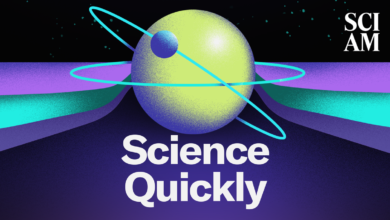Fastest Known Planetary System May Have Been Pushed by Our Galaxy’s Supermassive Black Hole

October 30, 2024
2 min read
Fastest Known Planetary System May Have Been Pushed by Our Galaxy’s Supermassive Black Hole
This blazingly-fast star is shooting through the Milky Way with a planet in tow

Hubble Space Telescope’s view of the dense region of stars near the Milky Way’s center, called the galactic bulge.
Our solar system orbits the Milky Way galaxy once about every 225 million years, whipping along at 230 kilometers per second (a staggering rate that we don’t feel because the whole thing moves at the same constant velocity). But a new study suggests we’re a cosmic slowpoke compared with one system in our galaxy that was somehow flung to a velocity of 541 kilometers a second—making it the fastest known planetary system.
“This velocity was extremely high and kind of shocking,” says University of Maryland astrophysicist Sean Terry, lead author of the study, which has been posted on the preprint server arXiv.org and submitted to the Astrophysical Journal. “It opens up a regime of questions about the survivability of these types of systems.”
This galactic speed demon appears to have a red dwarf star smaller and dimmer than our sun. It’s about 25,000 light-years from Earth and some 1,000 light-years away from our galaxy’s center. Astronomers discovered the star and a suspected accompanying planet after a 2011 microlensing event called MOA-2011-BLG-262, when the system passed in front of a background star and warped the latter’s light.
On supporting science journalism
If you’re enjoying this article, consider supporting our award-winning journalism by subscribing. By purchasing a subscription you are helping to ensure the future of impactful stories about the discoveries and ideas shaping our world today.
Terry and his colleagues observed the system again in 2021 from the W. M. Keck Observatory in Hawaii. They found that its known planet is likely a gas giant with about 29 times Earth’s mass that orbits its star at a distance between those at which Venus and Earth orbit the sun. (The system may have unseen planets as well.) The researchers also mapped the system’s position in the 2021 data relative to where it was about a decade prior, revealing how fast it traveled.
This speed suggests that the system’s star might be a hypervelocity star, an example of a rare class of stellar objects that have been sped up by past encounters with other stars—or even a gravitational slingshot from the supermassive black hole at the center of our galaxy. These objects travel faster than 500 kilometers a second, and the fastest known one hurtles at more than 2,000 km per second. “It’s this really exotic subset of stars,” Terry says, estimating that the system’s speed more than doubled after its own dramatic encounter. No hypervelocity stars have been found with planets, he adds.
Jessie Christiansen of the NASA Exoplanet Science Institute, who was not involved in the study, says the system offers clues about what worlds exist in the dense region of stars at our galaxy’s center. We don’t know if being in that galactic bulge “impacts the types of planetary systems that are formed,” she says.
Although the speedy system’s known planet orbits far from the zone around a red dwarf where liquid water (and therefore life as we know it) could persist on the surface, its existence suggests planets can survive the “somewhat chaotic interaction” that occurs when stars are accelerated to immense speeds, Terry says. “This might open up a new study of the origin and evolution of planets around very high-velocity stars,” he adds.




